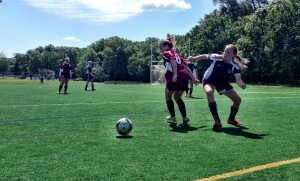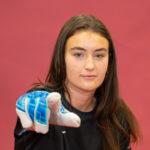Grip and Rip! Why we’re shopping for soccer cleats all wrong
By Jennifer Schwartz
 Editor’s note: Jennifer Schwartz is the owner of Impact Fitness DC, a professional private training company providing fitness services to female athletes, teams, individuals, and small groups in Washington, D.C. She holds a certified mastery in biomechanics with a specialization in resistance training and muscle activation techniques™, and is also a United States Soccer Federation-licensed coach with the Alexandria Soccer Association. Soccer Wire is very pleased to present Jennifer’s perspectives on biomechanics and injury prevention.
Editor’s note: Jennifer Schwartz is the owner of Impact Fitness DC, a professional private training company providing fitness services to female athletes, teams, individuals, and small groups in Washington, D.C. She holds a certified mastery in biomechanics with a specialization in resistance training and muscle activation techniques™, and is also a United States Soccer Federation-licensed coach with the Alexandria Soccer Association. Soccer Wire is very pleased to present Jennifer’s perspectives on biomechanics and injury prevention.
I recently had the pleasure of spending a hefty amount of time with a colleague of mine at a big-name retail store. She is more than just a shopping buddy; we’ve spent hours collaborating on projects, studying, and discussing the relativity of foot mechanics in regard to human movement. On this particular shopping trip, we were able to apply our conversations to the ample supply of soccer cleats we stumbled upon.
Our conclusions were disturbing.
The shiny, heavily-marketed cleats (naturally, with the biggest endorsements) were also potentially the most offensive in terms of foot mechanics. My colleague, a former professional ballet dancer, had never had a chance to really examine a soccer player’s sole piece of equipment. I used this ideal opportunity to describe the actions of player and cleat to the playing surface: GRIP and RIP!
The better we connect to the surface, the more opportunity for optimal force, movement and performance become available. A repetitive motion with less surface contact and an ill-fitting, overly tight boot would still give decent results, especially with a well-developed player, but the time will come when the external forces become too excessive for the player’s ability to generate appropriate internal force.
This is when speed becomes harmful—rapid change in speed will soon be too much for the player’s joints and something will give in to excessive external force, resulting in an overuse injury.
The marketing frenzy created by sportswear companies confuses us into focusing on weight and boot material when the spotlight should actually be on how the boot contacts the ground. My professional opinion is that the shape of the boot, in terms of fit, deserves higher weight than other boot specifications. We can now delve into the massively important feature of cleat placement and blade/stud shape.
How does the structure of a cleat enhance the technology of our feet?
The engineering and structure of the foot guide the transmission of forces in leg movement, adjust speed and stride as the body moves over the foot, assist in the generation of hip power needed for striking and sprinting, and allow for our bodies to pivot without toppling over. We can prevent injury and ensure agile movement if we allow our feet to perform these integral functions in a boot that fits. What occurs at your feet has an impact on every single tissue and joint of the body and weight-bearing activity. *
Our bodies have built-in mechanisms to compensate for lack of movement at the foot, but it comes at a price if we let the corresponding joints pick up the slack for the range of motion we deny ourselves through ill-fitting boots.
So what does this mean for boot selection? For now, we’re going to focus on placement of the cleat in the shoe and blade shape.* A good choice is the harmonious combination of stud/blade placement, shoe structure and the way the blade/stud contacts the playing surface.
In order to achieve the perfect balance you want a wide blade on the outside lateral portions and a sufficient number of blades filling the interior. The data will back it up! Thinner, irregular studs have been linked to ankle instability. In a study comparing four different styles of boots over a three-year period, thinner, irregular shaped studs showed an increased risk in ACL tears when longer studs were placed solely on the outside lateral portion of the show (Lanham, 1996). Balance in placements and width of the blades are integral in preventing injury!

On a similar note, the contact the foot makes with the playing surface and amount of blades are just as important as width and style of blade. We don’t want to skate on the playing surface with too few blades. We want to grip on the pitch and have a substantial amount contact surface to use the forces of contact with the ground to execute the agile motion of the player. So how was it that the most popular boot we encountered on our shopping trip only had two studs on the heel and very thin blades?! There is literally no room for the GRIP and RIP we need on the pitch. Two heel studs would be more like a pair of skates; especially considering the lateral motion a soccer player relies on.
Surface area, number and thickness of the blade all contribute to how much stress is placed on each individual blade. An ideal balance of studs would create the perfect balance of friction and compression for gripping the ground and performing the intended action. If the boot has too few blades, you lose the mechanical advantage in stopping and starting. This could potentially wreak havoc on performance outcome—the athlete will have to work so much harder to perform a simple task, not to mention placing undue amounts of stress on the knee. Improper blade placement will almost directly cause overload to the ACL, and most likely injury.

Choosing a boot based on fit through the toes (please don’t crush them), avoiding the big endorsements and understanding the importance of contact surface is the best path for performance and injury prevention.
The boot is your soccer player’s only piece of equipment! The true tools for performance are in their development. Ryan Rich, the director of coaching at the Alexandria Soccer Association, had the following to say:
“The latest “technology” does not serve as a substitute for what really accounts for noticeable increases in player performance. If a player is not doing a significant amount of work on their own and learning how to play the game well through structured training, the soccer shoes’s technology does not matter. What makes a player special is not the boot they wear but the amount and quality of time they commit to improving their game.”
If the shiny endorsements and big-name boots are not part of your player’s foot fit profile, please steer clear. Your player’s feet need to function to make the best of their athletic gifts and commitment.
*Muscle Activation Techniques™ creator Greg Roskoph quote from Advanced Foot Function lecture
* “Blade” and “stud” are both types of cleats. Studs are conical. Blades are wide and sometimes thin, but longer than studs.
*Lambson, RB. Barnhill, BS. Higgens, RW. Football cleat design and its effect on ACL injuries: a three-year prospective study. American Journal Sports Medicine. 1996;24: 155-9
SOCCERWIRE MARKETPLACE
- Girls College ID Soccer Camp – Showcase Your Skills!
- Real Colorado Cup 2026
- Join a College Coaches Showcase Camp Today
- MICFootball Punta Cana 2026
- Dana Cup Hjørring 2026
- 15th Annual Loudoun Soccer College Showcase
- OFFICIAL FC BARCELONA SOCCER CAMPS - PROMO CODE: FCBSOCCERWIRE
- New England Copa Surf 2026
- Adidas National Cup 2026
- visitRaleigh.com Showcase Series 2025, hosted by NCFC Youth











